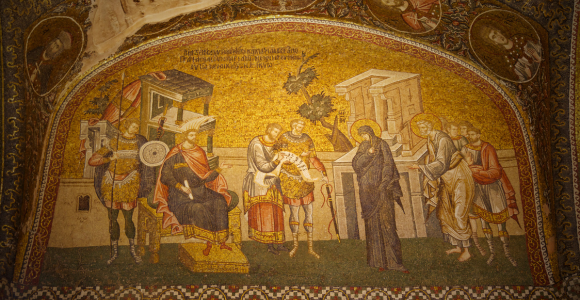
Our reading this week is from the gospel of John.
Six days before the Passover, Jesus came to Bethany, where Lazarus lived, whom Jesus had raised from the dead. Here a dinner was given in Jesus’ honor. Martha served, while Lazarus was among those reclining at the table with him. Then Mary took about a pint of pure nard, an expensive perfume; she poured it on Jesus’ feet and wiped his feet with her hair. And the house was filled with the fragrance of the perfume.
But one of his disciples, Judas Iscariot, who was later to betray him, objected, “Why wasn’t this perfume sold and the money given to the poor? It was worth a year’s wages.” He did not say this because he cared about the poor but because he was a thief; as keeper of the money bag, he used to help himself to what was put into it.
“Leave her alone,” Jesus replied. “It was intended that she should save this perfume for the day of my burial. You will always have the poor among you, but you will not always have me.” (John 12:1-8)
Part 1 of Mary, Christian Patriachy and the Existence of Poverty
Welcome Readers! Please subscribe to Social Jesus Here.
I understand why this passage is a Lectionary favorite during the Lenten season. Before we speak of whether poverty is inevitable or optional, let’s take a look at the woman named Mary mentioned in John’s version of the story.
John’s version of this story is very different from any of the other gospel versions of this story. In John’s version, we are in Mary, Martha, and Lazarus’ home. Mary’s act is one of gratitude, specifically for the events of the previous chapter. In the previous chapter, Lazarus, Mary’s brother, had gotten sick and died, and Jesus brought him back from the dead to live again.
Let’s also consider the other versions of this story in the gospels.
In Mark, the earliest version of this story, this event takes place not at Mary, Martha and Lazarus’ home but at the home of a leper named Simon.
“While he was in Bethany, reclining at the table in the home of Simon the Leper, a woman came with an alabaster jar of very expensive perfume, made of pure nard. She broke the jar and poured the perfume on his head.” (Mark 14:3-4)
Matthew’s gospel repeats to a large degree Mark’s version:
“While Jesus was in Bethany in the home of Simon the Leper, a woman came to him with an alabaster jar of very expensive perfume, which she poured on his head as he was reclining at the table.” (Matthew 26:6-7)
In Luke, we get a different version. Simon is no longer a leper; he’s now a Pharisee. This fits Luke’s overarching theme of Jesus being in conflict with the more nationalist sectors of the Pharisee community. And the woman is not nameless as in the previous gospels, but a woman who had “lived a sinful life.” This evolved detail also fits conflict growing in Luke of certain Pharisees being upset with Jesus’ association with tax collectors and “sinners.”
“When one of the Pharisees invited Jesus to have dinner with him, he went to the Pharisee’s house and reclined at the table. A woman in that town who lived a sinful life learned that Jesus was eating at the Pharisee’s house, so she came there with an alabaster jar of perfume. As she stood behind him at his feet weeping, she began to wet his feet with her tears. Then she wiped them with her hair, kissed them and poured perfume on them.” (Luke 7:36-38)
But in our reading this week, we are in Mary, Martha, and Lazarus’ home, not the home of Simon the Leper (Mark and Matthew) or Simon the Pharisee (Luke). The woman who interacts with Jesus is Mary of Bethany (Martha and Lazarus’ sister), not a woman who has lived a sinful life (Luke), nor an unnamed, morally upright woman who simply wants to anoint Jesus’ body before his death (Mark and Matthew).
What I believe is most important in all these versions of this story is that the woman mentioned is definitely not Mary Magdalene. Why is this clarification important?
In the early Jesus movement, Mary Magdalene was both an influential leader in the early movement and a symbol of support for women in leadership in the early church. Beginning in the 4th Century, though, we witness a shift to disparage women leaders, and Christianity moved toward a purely patriarchal form. The different versions of this story played a part in this history. We’ll begin unpacking this history, in Part 2.
Are you receiving all of RHM’s free resources each week?
Begin each day being inspired toward love, compassion, justice and action. Free.
Sign up at HERE.



















